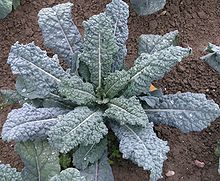Palm kale
The palm kale ( Brassica oleracea var. Palmifolia DC. ) Is a variety of the vegetable kale and belongs to the cruciferous family (Brassicaceae).
Other common names of this cultivated plant form in the German-speaking area are: Italian cabbage, Tuscan cabbage, black cabbage . One variety used as an ornamental plant is 'Negro Romano'.
Origin and Distribution
This cabbage form is considered to be the origin of many other cabbage forms such as marrow stem cabbage , head cabbage, Brussels sprouts and kale and was cultivated and used as far back as the Roman times. Benary also mentions this type of cabbage in his album as early as 1876 for Central and Northern Europe. Traditionally, it is still cultivated a lot in northern Italy, especially in Tuscany, where industrial cultivation was examined in 2003.
Description and ecology
The palm kale is a biennial herbaceous plant and can reach heights of up to 3 meters. It is not frost hardy in the temperate areas . It is not to be confused with the marrow stem cabbage , whose shoot is thicker and whose leaves are not blistered, but sometimes have slightly serrated, curled edges. The arrangement of the vesicular, slightly rolled down leaves is alternate and looks somewhat palm-like. The leaves are 60 to 80 inches long and 8 to 10 inches wide, dark green to black-green.
It blooms in the second year from May to August with light yellow flowers. Palm kale is self-fertile and pollination is done by bees, for example. The seeds ripen from July to September.
Pests
Kohlfliege , Small and Large White , white flies , Mealy cabbage aphid , clubroot , Alternaria .
ingredients
The older the leaves are, the more fibers (dry matter) they contain. Especially old leaves have a very high fiber content and are not qualitatively suitable for industrial processing. The nitrate content is also higher than in younger leaves. The nitrate content also increases with the age of the plants, but this does not affect the upper part of the plant.
use
Palm kale has a milder taste than kale. The finely cut leaves are used for salads or cooked vegetables. It is also ideal for Tuscan winter stews. A well-known use of the palm kale is the Portuguese cabbage soup caldo verde . Palm kale can also be blanched for later use and then stored frozen. Palm kale also has decorative value as a container plant in the garden or in front of the house. In the past, the long, woody stem axis was used to manufacture walking sticks
Individual evidence
- ^ Vilmorin-Andrieux & Cie, Les Plantes Potagères. Quatrième Édition, Paris 1925, pp. 152–153.
- ↑ Brassica oleracea palmifolia in Plants For A Future . Retrieved June 20, 2020.
- ↑ LF D'Antuono u. R. Neri: Traditional Crop Revised: Yield and Quality of palm-tree kale, grown as a merchanised industrial crop, as a function of cutting hight. In: Acta Hort. (ISHS) 598, 2003, pp. 123-127, doi : 10.17660 / ActaHortic.2003.598.17 .
- ↑ JE Staub: 75 Exciting Vegetables for Your Garden. Gibbs Smith, 2005, ISBN 1-5868-5250-7 , 2005, p. 119.
- ↑ Anton Oskar Klaußmann: cane plantations. In: Library of entertainment and knowledge, year 1909, ninth volume, pp. 221–224. Union Deutsche Verlagsgesellschaft, Stuttgart, Berlin, Leipzig.

